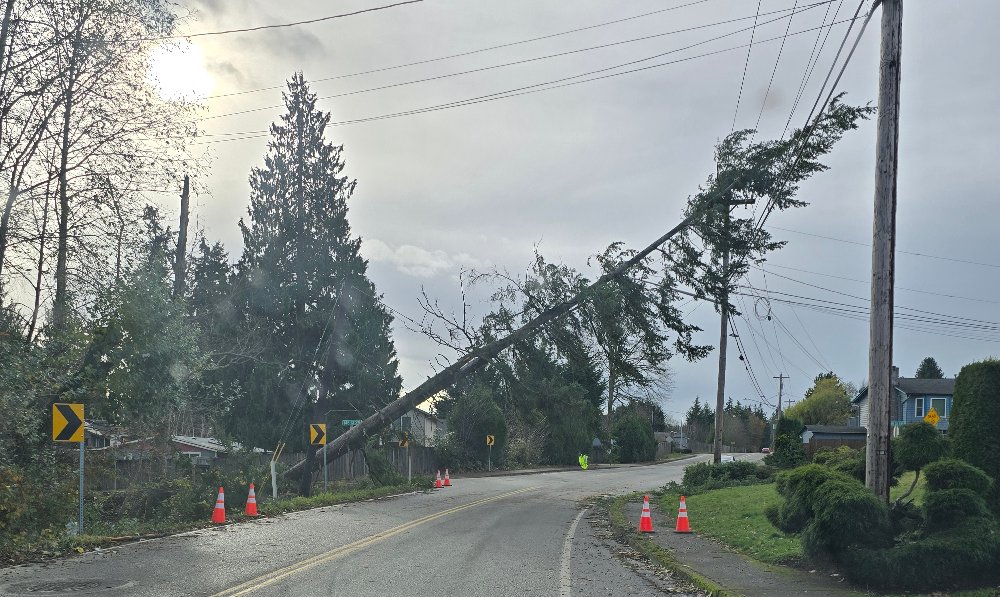November’s bomb cyclone, the windstorm that knocked out power to half a million residences in the Puget Sound region produced heroes who deserve our thanks this Thanksgiving weekend. For those of us in Seattle and adjacent suburban areas (Shoreline, Lake Forest Park, Burien, Renton, Tukwila, and Sea-Tac), the star players have been the crews that worked day and night restoring power to customers.
Seattle City Light restored electric power to more than 180,000 customers within a week, leaving only a few isolated residents without. The restoration of so many outages was a remarkable feat.
For me, the bomb cyclone storm brought back memories of the region’s last monster storm. That windstorm slammed the region leaving a path of destruction on Dec. 14 and 15, 2006. At that time, I was just midway through my first term as a Seattle Councilmember. As a newbie, it had been my lot to chair the council’s Energy Committee which oversees Seattle City Light, one of the nation’s largest municipally-owned power companies.
Named the Hannukah Eve Storm, the 2006 tempest with its 70-mile an hour gusts was especially disastrous. It was preceded by a record 16 inches of rain in November. When the winds struck, rain-sodden trees and limbs toppled, wiping away power lines and leaving thousands of City Light customers without power or any promise for when it might be restored. Following the windstorm, the weather turned bitterly cold.
At the end of the first two days, 48 percent of the power outages had been restored; but that left many thousands still shivering in the dark. Seattle City Light crews were putting in 17-hour days to rebuild virtually the entire city’s electrical distribution system. Main distribution lines had to be reconstructed before feeder lines could be powered. Reinforcements were unavailable because nearby utilities here had been similarly impacted. Eventually City Light Superintendent Jorge Carrasco sought help from utilities as far away as Ohio.
Meanwhile, my council staff and I worked with Mayor Greg Nickels to establish warming centers for people suffering the cold without power. We circled the city, visiting shelters staffed with hard-working Parks Department employees who had been pressed into service, providing hot meals and setting up cots.
Before power could be restored throughout the city, 13 people died – most from carbon monoxide poisoning. Seattle actress Kate Fleming drowned in her basement on Dec. 14. Others died when crushed by falling trees and a man and his dog were electrocuted by a downed power line.
Eventually power was fully restored, but some customers had waited until just two days before Christmas – a total of eight days and 17 hours without power. During the height of the emergency, I received death threats, several serious enough for referral to the police. One angry caller said he could see a dangling wire and if we’d just reconnect that wire (to a dead feeder line) he’d have electricity. He threated, “Restore my power or I’ll kill you.”
Even before all the lights were back on, the council began asking questions about the storm response and how we could do better in the future. We hired Davis Consulting to prepare a report. The consultants submitted a 100-page timeline detailing what worked and what didn’t. The report included a lengthy to-do list for City Light. By that time, the utility was already implementing some of the suggested fixes.
It helped that the city was working with a utility that could act quickly. Seattle City Light has a long and venerable history, tracing its beginnings to 1905 when voters granted the city authority to buy out Seattle Electric Company, a private company known for poor service and outrageous bills. Voters next approved a $500,000 bond to construct a power plant at Cedar Falls on the Cedar River. Separation of water and power utilities followed.
City Light Superintendent. J. D. Ross, often called “the father of City Light,” recognized the need to expand the city’s power grid and obtained federal approval for the city to construct dams on the Skagit River. Today that system supplies 40 percent of the city’s power usage.
Seattle benefits from its connections to a regional power grid and from cooperative agreements including one with Canada. It has helped immeasurably that the city’s utilities (power, water, sewer, drainage, and solid waste) have always answered — not to a private industry concerned with profits — but to the interests of We the People.
Discover more from Post Alley
Subscribe to get the latest posts sent to your email.

Absolutely. My neighborhood was spared a power outage this time, but I went through a long and very cold one after the 2006 storm. The people who clean up and restore civilization to so many people here are local heroes.
I could not agree more. Big thank you as well to Metro transit drivers who were definitely not calling it in during this last storm. Gratitude is especially due to the driver who had a tall fir crash on top of his bus, as he was driving down 35th N.E. in North Seattle. Thankfully, the bus was empty and he wasn’t hurt. I’m told by another driver that he’s taking a little leave…
Don’t forget Puget Sound Energy. They got my power on the Eastside back within a day and a half.
A Seattle Times editorial lauded another hero: KC exec Dow Constantine for foresight in expediting a project to keep King County’s wastewater treatment operating during power outages. It protected the health of our local waters during the storm.